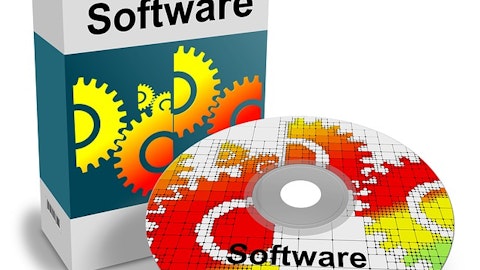Genasys Inc. (NASDAQ:GNSS) Q4 2023 Earnings Call Transcript December 7, 2023
Operator: Good day, ladies and gentlemen, and welcome to the Genasys Fiscal Year 2023 Conference Call. [Operator Instructions]. At this time, it is my pleasure to turn the floor over to your host, Brian Alger, SVP of Investor Relations and Corporate Development. Sir, the floor is yours.
Brian Alger: Thank you, Karen. Good afternoon. Welcome to Genasys’ Fiscal 2023 Fourth Quarter and Full Year Financial Results Conference Call. I’m Brian Alger, SVP, Investor Relations and Corporate Development for Genasys. With me on the call today are Richard Danforth, our CEO; and Dennis Klahn, the company’s CFO. During today’s call, management will make forward-looking statements regarding the company’s plans, expectations, outlook, and future financial performance that involve certain risks and uncertainties. The company’s results may differ materially from the projections described in these forward-looking statements. Factors that might cause such differences and other potential risks and uncertainties can be found in the Risk Factors section of the company’s Form 10-K for the fiscal year ended September 30, 2022, or the 10-K that’s going to be filed later today.
Other than the statements of historical fact, forward-looking statements made on this call are based only on the information and management’s expectations as of today, December 7, 2023. We explicitly disclaim any intent or obligation to update those forward-looking statements, except as otherwise specifically stated. We will also discuss non-GAAP financial measures and operational metrics, including adjusted EBITDA, bookings, backlog, and adjusted net loss, which we believe provide helpful information to investors with respect to evaluating the company’s performance. A reconciliation of adjusted EBITDA to GAAP financial metrics, please see the table in the press release issued by the company at the close of the market today. We consider bookings and backlog leading indicators of future revenues and use these metrics to support production planning.
Bookings is an internal operational metric that measures the total dollar value of customer purchase orders executed in a given period, regardless of the timing of the related revenue recognition. Backlog is a measure of purchase orders received that are scheduled to ship within the next 12 months. Finally, a replay of this call will be available in approximately four hours through the Investor Relations page on the company’s website. Now at this time, it’s my pleasure to turn the call over to Genasys’ CEO, Richard Danforth. Richard?
Richard Danforth: Thank you, Brian, and welcome, everyone. Before we get into discussing the results of last fiscal year and our outlook for fiscal year 2024 and beyond, I want to take a moment to thank our shareholders that have been incredibly supportive and resilient through our transition to a more balanced hardware and software company. The investments we have made over the past two years are beginning to bear fruit, and I have increasing confidence that these investments were not only well made, but will yield substantial returns in the not-too-distant future. Using the balance sheet and profits from the hardware business, in less than two years, we have incubated a strategic software business that has already generated a recurring revenue stream in excess of $5 million, with a clear line of sight to roughly double in 2024.
We appreciate your support, and we look forward to delivering the results to generate the return you patients deserves. Moving on. As expected, we exited fiscal year 2023 with over $10 million in cash and no debt. However, finishing out the quarter, we correctly assessed that the federal government was likely to, once again, delay approving a DoD budget. And as such, FY ’24 orders from this U.S. government would be delayed. This is a further complication to the numerous order delays that we experienced throughout fiscal 2023. With this in mind, we pursued and closed on a follow-on equity offering of 5.75 million common shares, raising net proceeds of approximately $10.6 million to protect the investments that we have been made to date and to assure that we remain positioned to capture the opportunities before us.
Moving on. It is worth noting that the statewide RFP for Florida that we discussed on last quarter’s call resulted in a no award decision. And earlier this week, the state issued a new RFP that we plan on responding to before the end of this month. As was the case in August, we continue to believe we have the best and most complete offering for the state of Florida and its visitors and residents. Now on to the financial discussions. As we announced in mid-December, financial results for the fiscal fourth quarter were below expectations due to hardware opportunities that slipped out of the quarter and into fiscal 2024. Software bookings and revenue were in line with expectation, with recurring revenues achieving a new company record. As we discussed in our September announcement, both our hardware and software pipelines are rapidly expanding.
Not including the $25 million of hardware bookings that slipped from fiscal 2023, today’s hardware pipeline is more than 150% higher than it was at the same time last year. For software, in addition to growing our software bookings more than 100% in fiscal 2023, both the number of deals and the dollar value of the software opportunities has never been higher. Fourth quarter recurring revenue was up 43% year-over-year and 21% quarter-over-quarter. As most of you are aware, there is typically a one-quarter to two-quarter between when we book a software order until initial revenue recognition, which means we have already won recurring revenue beyond what we report in any given period. Including those additional contracts, our ARR has increased roughly 20% since our conference call in August, not including the contributions of Evertel.
In early October, just after the fiscal year ended, we completed the acquisition of Evertel. Evertel’s fully compliant, cross-agency communication application enables an unparalleled quality of response when paired with Genasys Protect. Evertel has been rebranded Genasys Protect CONNECT, and we have integrated their go-to-market and positioning with our own. When we purchased Evertel, their ARR was approximately $800,000. In the two months since the acquisition, we have already begun to realize sales synergies between our respective customer bases. Today, we have over 200 customers, with nearly 20,000 paying subscriptions of CONNECT. For anyone interested in learning more about CONNECT, Evertel’s co-founded, Jeff Halstead, will be hosting a webinar on December 14, with two of our customers, to discuss how they each use the solution today.
To register for this event, just go to the CONNECT section of our Solutions page at genasys.com. In addition to acquiring Evertel, we recently announced two strategic partnerships that we believe further differentiate our Protective Communications platform from legacy mass notification offerings. The first was with Tablet Command, a must-have software solution found in the front seat of fire trucks across the country and on over 30,000 first responders’ mobile devices. By integrating our EVAC software with Tablet Command, first responders now have the ability to deploy and manage resources on a single plane of glass in concert with emergency managers throughout a critical event. We also extended the capabilities of Genasys Protect with a newly announced relationship with Ladris AI.

Ladris’ software brings AI-driven, near real-time traffic modeling to the Genasys Protect platform to determine the most efficient way to get large populations out of a given area. Further differentiating Genasys Protect is our acoustic systems. As the disaster in Lahaina, Hawaii catastrophically demonstrated, cell, radio, and Internet-based communications are not adequate and rapidly changing in fast-moving emergencies. Moreover, the inherent limitations of siren technology actually inhibited emergency managers’ communications efforts in Lahaina. As many of you know, Genasys’ voice quality acoustic systems are not reliant on the power grid and are equipped with satellite communication channels that enable emergency managers to clearly and concisely communicate to those in harm’s way, even when the power and traditional communication lines have been compromised.
In the wake of the global attention created in Hawaii, we received a number of inbound inquiries from customers looking to augment their software offerings with Genasys Protect ACOUSTICS. Combined, we believe the Genasys Protect platform with the additional capabilities of CONNECT, Tablet Command, and Ladris, is the most complete and technologically advanced protective communication offering available. In its study released earlier this week, Forrester ranked Genasys as a strong performer in its broad-based critical event management wave analysis. Next, based on current orders, contracting activity, and pipeline, we are confident that the software revenues for fiscal 2024 will at least double over fiscal 2023. As we have discussed on last quarter’s call, 2023 hardware bookings and revenue were abnormally difficult to register.
Since I arrived at this company, we have seen steady growth in our hardware revenues six out of the last seven fiscal years, with a CAGR through fiscal 2022 over 20%. 2023 was the one year where multiple opportunities pushed out of the revenue, declining year-over-year. So, it would be convenient to point to a global politics or economics to explain the slippage, there is no one thing that is consistent among the various deals that have been delayed. None of the deals that were delayed have been canceled or awarded to a competitor. Looking at our forecast and plan for fiscal 2024, we see enormous potential for a significant rebound in our hardware business. That said, certainty in the timing on a number of significant deals is not going to come before federal budget is approved.
Others are progressing, but could be further delayed by a government shutdown. As a result, we expect that 2024 hardware of revenues will be even more back-end loaded than our typical seasonality has indicated. It is important to note that we still expect a rebound in our hardware business in fiscal 2024 approaching the levels of 2022, up material — materially from the abnormal 2023 results. A number of large opportunities could positively impact our 2024 results. There was a large critical infrastructure protection opportunity that requires all of the Genasys Protect platform, including significant ACOUSTICS revenue as well as recurring software revenues from the Genasys Protect suite of solution. On October 10, we announced that we were awarded a $1 million contract for the CROWS-AHD program.
With a fiscal 2024 DoD budget in place, we expect to receive initial production orders in our fiscal 2024. As we discussed on last quarter’s call, the CROWS-AHD program is expected to be of similar size to the prior Army program of record. Pending grant approval, we have already secured a multimillion-dollar acoustic award that will augment existing Genasys Protect software customers. Bottom line, Genasys has enough opportunities for growth. Summarizing the business. As we enter fiscal 2024, we have a burgeoning software business with over 400 customers generating meaningful ARR that is expected to roughly double in the next 12 months. Supporting this growth is a rebounding hardware business that historically has seen high-teen adjusted EBITDA margins.
Our balance sheet, fortified by the recent public offering, has no debt and adequate resources to not only weather the current storm, but to also facilitate the growth of our business back to a positive cash flow and beyond. In closing, I want to express my gratitude and appreciation for the shareholders that have remained supportive of the company over the past couple of years of transition. Myself and the entire Genasys team is committed to completing our objective to build a larger, more balanced business that operates globally, selling both hardware and software, resulting in more predictable revenue and considerably higher profit margins. Now I’ll turn the call over to Dennis to go through [Audio Gap]
Dennis Klahn: Revenues for the fiscal ’23 fourth quarter were $10.7 million, a decrease of 33% over the prior year’s record revenue quarter. As compared to the same prior year period, total software revenue declined 3% to $1.1 million, due to a decline in professional services. Hardware revenue decreased 36% to $9.6 million, for all the reasons Richard discussed earlier. For the full fiscal year, total revenue was $46.7 million, a 14% decrease from fiscal 2022 revenues of $54 million. Software revenues for fiscal ’23 increased 23% to $3.8 million, while hardware revenues decreased 16% to $42.9 million in fiscal 2023. Gross profit margin was 49.6% in this year’s fiscal fourth quarter, consistent with the prior-year quarter. For most of fiscal 2023, the gross margin percentage was negatively impacted by inflationary pressures.
This has been partially offset by the increasing software revenues that carry higher gross margins. Quarterly operating expenses were $7.9 million, up from $7.5 million, excluding the $13.1 million goodwill impairment charge in the fourth quarter of fiscal 2022. On the full fiscal year, operating expenses grew $3.1 million to $32.7 million. The year-over-year increase is directly tied to the planned investment to grow and accelerate our software business. On a GAAP basis, our current fiscal year fourth quarter operating loss was $2.6 million compared to a $396,000 profit in the year-ago quarter excluding the onetime goodwill impairment charge. Adjusted EBITDA, which excludes noncash stock comp, was a negative $1.7 million compared to last year’s positive $1.6 million.
On the full fiscal year, our 2023 GAAP operating loss was $11 million compared to fiscal 2022’s $2.4 million operating loss, excluding the goodwill impairment charge. Fiscal 2023 adjusted EBITDA was a negative $6.8 million compared to last year’s positive $2.4 million. GAAP net loss for the fourth quarter and fiscal year 2023 was $10.1 million and $18.4 million, respectively. Excluding this year’s $7.4 million noncash deferred tax expense and last year’s $13.1 million goodwill impairment charge for the fourth quarter and full-year net loss for 2023 of $2.7 million and $11 million, respectively, compares to $664,000 and $3.1 million net losses in the same periods in fiscal 2022. Cash, cash equivalents, and marketable securities totaled $10.1 million as of September 30, 2023, compared with $19.9 million as of the prior year-end.
Cash used in operating activities in the fiscal year was $9.6 million. Since the fiscal year-end, the company has completed the acquisition of Evertel and closed on the sale of 5.75 million common shares. The net cash proceeds from those two subsequent events was $9.6 million. With our current backlog and forecasted bookings, we expect fiscal 2024 to be up materially from fiscal 2023. As Richard mentioned, we expect software revenues to at least double, and hardware revenues should rebound close to fiscal 2022 levels. We do expect hardware revenues to be significantly skewed to the second half of fiscal ’24, with numerous opportunities pending budget approval and appropriation at the federal level. Including the addition of Evertel, we expect fiscal 2024 cash operating expenses to increase between 10% and 15% over — year-over-year.
Thus, adjusted EBITDA loss should improve in fiscal ’24 versus fiscal ’23. Now I’d like to open the call to Q&A. Operator.
See also Jim Simons Stock Portfolio: 10 Top Stock Picks and 13 Best Clothing Stocks to Buy Now.
Q&A Session
Follow Genasys Inc. (NASDAQ:GNSS)
Follow Genasys Inc. (NASDAQ:GNSS)
Operator: [Operator Instructions]. And we’ll take our first question from Brian Colley from Stephens. Please go ahead.
Brian Colley : So, Dennis, I’m curious, just if we can put a finer point on the expectations for EBITDA here in FY ’24, from what I can tell in the investor deck, it kind of looks like the illustrative chart that you have in there, as you’re around breakeven, is that kind of how we should think about it?
Dennis Klahn: I don’t — for the full year, no, I don’t think that’s — the back-end is more heavily weighted with revenue. And that’s more likely in the back half of the year, but not for the total year.
Brian Alger: Brian, this is Brian Alger. The slide you’re referring to is a legacy slide from last quarter. We’ll be updating the slide deck probably overnight. Bear in mind, we do have costs that came on board, and we referred to them on the operating expense side coming from the acquisition of Evertel.
Brian Colley : Got it. That’s helpful. And then any sense you can give me for the magnitude of how much the revenue — the hardware revenues will be skewed first half versus second half? Are we talking 70% of hardware revenues in the back half or more than that?
Richard Danforth: Brian if you look at a typical year for us, substantially more than 50% of the — correct me if you think I’m wrong, revenue is in the second half.
Dennis Klahn: Yes. Over the last three years, it’s been right around 60%.
Richard Danforth: 40%, 60%. It will likely be more skewed to 30-70 kind of thing.
Brian Colley : Okay. That’s very helpful. And then I wanted to ask about Evertel. So, you now have a much more comprehensive unified platform with Genasys Protect, with GEM, Zonehaven, and Evertel kind of under the same roof now. How should we think about like the incremental uplift from upselling Zonehaven and also upselling Evertel to like existing GEM customers? I’m not necessarily asking for a pricing number, but I’m just kind of curious like what the ASP uplift looks like from upselling those additional solutions?
Richard Danforth: We’ll see, but that’s certainly one of the reasons we bought them. In the two months we’ve had them, we’re probably seeing their ARR go up by 20%. And — the use of Evertel historically has been in police forces. But the application is there for first responders and fire, which we have a large installed base with other hardware and software solutions. So, our expectations are very high that there’ll be a lot of up and cross-selling.
Operator: And we’ll take our next question from Mike Latimore from Northland Capital. Please go ahead, Mike.
Michael Latimore : Great. Congrats on the strong software growth. I guess just on your last comment there, that ARR is already up 20% of Evertel. Is that because you guys have brought in new customers? Or is it just stuff they’ve deployed? Or like what’s driving that?
Richard Danforth: Some of it was what was in their pipeline. Some of it is a consequence of — we’ve put together a five-person sales team for Evertel. What sales force Evertel had was two people. And right now, there’s five. And again, we have a very large installed base, as I mentioned, over 400 customers combined. So, these — the calls are not cold calls, there are calls to existing customers.
Michael Latimore : Got it. And then I think I know the answer to this, but you’re expecting your software business to at least double year-over-year. I assume that’s both reported revenue as well as ARR?
Richard Danforth: Yes.
Michael Latimore : Okay. Got it. And then on the $25 million of hardware business that slipped out of ’23, how much of that is U.S. versus international?
Richard Danforth: Approximately 70-30 U.S.-international.
Michael Latimore : Got it. Okay. And then just last, I know the Maui fire has prompted a lot of states to reach out to you guys. What — do you feel like there’s a good chance that they will be making decisions from these other states this fiscal year?
Richard Danforth: I’d say I’m hopeful for that, Mike. It’s — whenever there’s an emergency, there’s an initial spike of interest and concern and it tends to wane pretty quickly. I think if you — the world saw what happened in Lahaina, and that will result in additional business for Genasys. Not clear to me at all on the timing of that quite yet.
Operator: And we’ll take our next question from Scott Searle from ROTH. Please go ahead, Scott.
Scott Searle : Good afternoon. Thanks for taking my questions. Maybe to dig in first on the hardware front. Certainly, sort like a back-end loaded year. There were a couple of numbers that you threw out. There was a 150% number. It wasn’t clear to me if that was pipeline or backlog. I was wondering if you could clarify that? And also give us an idea of what that coverage ratio looks like in terms of that pipeline, given that we’re talking about recovering to about $45 million, $48 million in terms of hardware sales, big ramp in the second half. And also, I believe the gross margins had been under pressure on the hardware front. I thought they were expected to come back. It looks like that’s sort of embedded in the results. I was wondering if you could provide some more color on that front.



